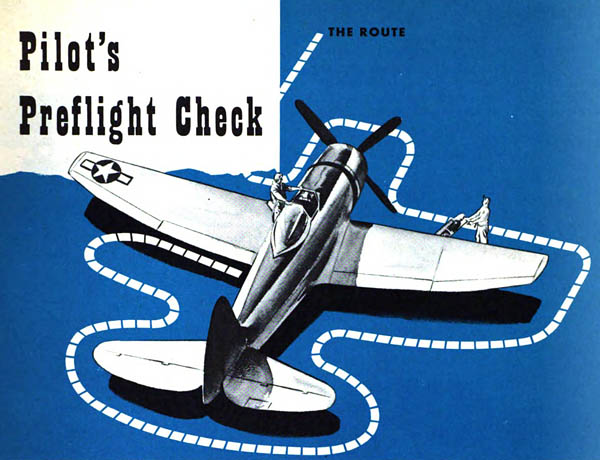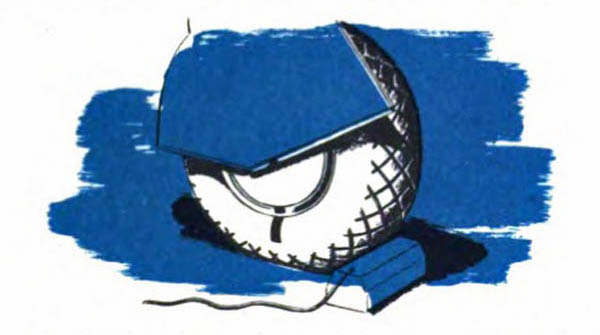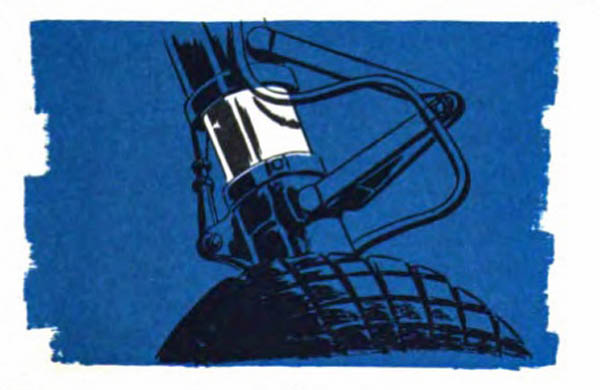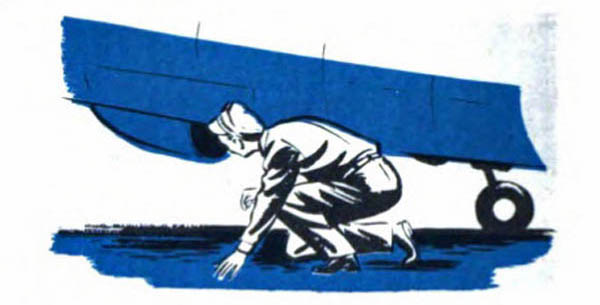P-47N pilot’s preflight check, from: Pilot Training Manual for the Thunderbolt P-47N, Headquarters, AAF Manual 51-127-4, Army Air Forces, Washington, D.C., September 1945.
Pilot’s Preflight Check
The preflight check starts before you reach your airplane. Survey the proposed taxiing route for any possible future obstruction, such as a fuel truck about to move. Study the ramp area for stray equipment or rubbish and rags that might be blown into the airscoop or tail assembly by prop blast.
See that a ground crewman is on hand with a fire extinguisher and portable battery cart.
If the plane has been standing for more than two hours, instruct the ground crew to pull the prop through four blades. Two complete revolutions of the engine are needed to clear the lower cylinders of oil.
A complete circuit of the plane, starting at the left wingtip, is required to check the P-47N.
The sketch shows your route as you check the following items:
1. Pitot tube–Cover removed.
2. Navigation light–For cracks and cleanliness. (Same check on right wing.)
3. Landing light–For cracks and cleanliness.
4. Guns–Plugs inserted and blast tubes snug. (Same check on right wing.)
5. External wing tank (if carrying)–For firm connections and solid bracing. (Same check on other external tanks.)
6. Wheels–Chocked.
7. Turbo waste gates–Open. (Same check on other side.)
8. Tires–For proper inflation and alignment on wheels.
9. Oleo struts–For some extension. (Extension varies with loading.)
10. Inspection plates–All closed.
11. Propeller–For nicks.
12. Airscoops–For foreign objects.
13. Leading edge of wings–For dents.
14. Camera glass–For cracks, scars, or yellowed appearance.
15. Ailerons–For foreign objects.
16. Fuel drain cocks–Safetied.
17. Intercooler doors–Open. (Same check on other side.)
18. Radio antenna–For proper tension and security of mounting.
19. Tail surfaces–For damage or foreign objects.
20. Tailwheel–For proper extension.
21. Interior of supercharger flight hood–For accumulated oil or dirt.
22. Canopy–For scratches, scars, dirt, or oily film.The outside bead of the tire tread, under normal loading, should just touch the ground. A line painted from the rim to the tire indicates proper alignment. If the line has parted, strain is being placed on the inner tube valve stem. Write up the lack of a line in Form-1A.
Lack of proper oleo extension to cushion a landing places a terrific strain on the tires and wings. A blowout or weakened wing structure may result. Any time the oleos are down, therefore, instruct the crew chief to check them.
Fire Prevention
To inspect the supercharger hood, you must squat and look inside. A film of oil doesn’t matter, but wipe up any large drops or small pools. Hot exhaust gases ignite such accumulations every time.
See that all three drain holes in the hood are unstopped. The holes prevent oil from collecting.
As a pilot new to the N you may not know whether nicks in the prop, dents in the wing, oil on the plane, or other defects are serious. If you are in doubt, call the engineering officer. You are entitled to be satisfied with the condition of your plane before taking off.
Here’s a tip: If a plane is generally dirty, inspect it with utmost care. Such a condition denotes sloppy maintenance.
The first pilot of the day has an additional check: The battery drain jar, reached by unfastening the cowling on the right side of the accessories section.
See that the inch-thick pad in the bottom is well saturated with neutralizing fluid–sodium bicarbonate and water. The fluid neutralizes battery acid that bubbles up during flight. It must be renewed every four to six flights.
Inspect tubes leading from the battery for kinks or bends. Battery acid causes these tubes to kink easily. See that the opening of the impact tube, protruding from the lower right side of the accessories section, faces to the front. The tube keeps the proper air pressure in the jar.
Unless the drain jar is properly maintained, excess acid creates combustible gases in the battery, or weakens other parts by corrosive action.














Don’t walk into the propeller.